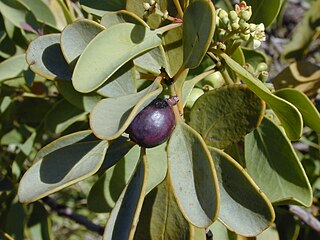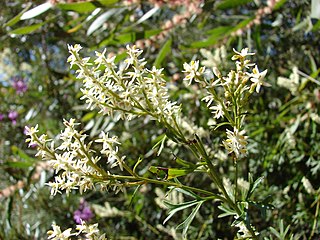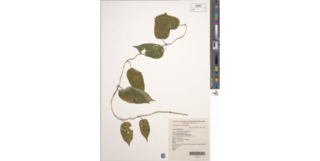
Scaevola is a genus of flowering plants in the Goodenia family, Goodeniaceae. It consists of more than 130 species, with the center of diversity being Australia and Polynesia. There are around 80 species in Australia, occurring throughout the continent, in a variety of habitats. Diversity is highest in the South West, where around 40 species are endemic.

The Santalaceae, sandalwoods, are a widely distributed family of flowering plants which, like other members of Santalales, are partially parasitic on other plants. Its flowers are bisexual or, by abortion, unisexual. Modern treatments of the Santalaceae include the family Viscaceae (mistletoes), previously considered distinct.

Knightia is a small genus of the family Proteaceae endemic to New Zealand, named in honor of Thomas Andrew Knight. One extant species, K. excelsa (rewarewa) is found in New Zealand. Two further Knightia species are found in New Caledonia, although they were placed in the genus Eucarpha by Lawrie Johnson and Barbara Briggs in their influential 1975 monograph "On the Proteaceae: the evolution and classification of a southern family", a placement supported in a 2006 classification of the Proteaceae. A fossil species from upper Miocene deposits in Kaikorai has been described as Knightia oblonga. Knightia has been placed in the tribe Roupaleae of the subfamily Grevilleoideae.

Leucopogon is a genus of about 150-160 species of shrubs or small trees in the family Ericaceae, in the section of that family formerly treated as the separate family Epacridaceae. They are native to Australia, New Zealand, New Caledonia, the western Pacific Islands and Malaysia, with the greatest species diversity in the south-west of Western Australia. Plants in this genus have leaves with a few more or less parallel veins, and tube-shaped flowers usually with a white beard inside.

Myoporum is a genus of flowering plants in the figwort family, Scrophulariaceae. There are 30 species in the genus, eighteen of which are endemic to Australia although others are endemic to Pacific Islands, including New Zealand, and one is endemic to two Indian Ocean islands. They are shrubs or small trees with leaves that are arranged alternately and have white, occasionally pink flowers and a fruit that is a drupe.

Persoonia, commonly known as geebungs or snottygobbles, is a genus of about one hundred species of flowering plants in the family Proteaceae. Plants in the genus Persoonia are shrubs or small trees usually with smooth bark, simple leaves and usually yellow flowers arranged along a raceme, each flower with a leaf or scale leaf at the base. The fruit is a drupe.

Isopogon, commonly known as conesticks, conebushes or coneflowers, is a genus of about forty species of flowering plants in the family Proteaceae, and are endemic to Australia. They are shrubs with rigid leaves, bisexual flowers in a dense spike or "cone" and the fruit is a small, hairy nut.

Pittosporaceae is a family of flowering plants that consists of 200–240 species of trees, shrubs, and lianas in 9 genera. Habitats range from tropical to temperate climates of the Afrotropical, Indomalayan, Oceanian, and Australasian realms. The type genus is Pittosporum Banks ex Gaertn.

Petrophile is a genus of evergreen shrubs, in the family Proteaceae. The genus is endemic to Australia. Commonly known as conebushes, they typically have prickly, divided foliage and produce prominently-displayed pink, yellow or cream flowers followed by grey, conical fruits.

Symphionema is a genus of two species of small shrubs in the family Proteaceae. Both species are endemic to New South Wales in Australia.

Oxylobium, commonly known as shaggy-pea, is a genus of flowering plants in the family Fabaceae all of which are endemic to Australia.

Geitonoplesium is a monotypic genus in the family Asphodelaceae, containing the sole species Geitonoplesium cymosum, commonly known as scrambling lily. The species is a perennial evergreen scrambling vine found in rainforests, sclerophyll forests and woodlands of eastern Australia, and parts of Malesia and Melanesia.

Wurmbea is a genus of perennial herbs in the family Colchicaceae, native to Africa and Australia. There are about 50 species, with about half endemic to each continent.

Acidonia microcarpa is a species of shrub in the plant family Proteaceae. It is the only species in the genus Acidonia. It is endemic to the south coast of the Southwest Botanic Province of Western Australia.
Plantago debilis is a species of herb native to Australia. Common names include shade plantain and weak plantain.

Trichodesma zeylanicum, commonly known as Northern bluebell, camel bush or cattle bush, is a herb or shrub native to Australia.

Mitrasacme is a genus of plants in the family Loganiaceae. The genus includes 55 species mostly in Australia, though also extending to various parts of Asia and the Pacific Islands. Two species also occur in China.
Eucarpha is a genus of flowering plant of the family Proteaceae, endemic to New Caledonia. Two species are recognised. Up to 1975, these were classified within the genus Knightia until Lawrence Johnson and Barbara G. Briggs recognised their distinctness, particularly their prominent bracts, in their 1975 monograph "On the Proteaceae: the evolution and classification of a southern family". Nomenclatural combinations for these two species in the genus Eucarpha were published in 2022.

Deeringia is a genus of flowering plants in the amaranth family Amaranthaceae. Its native range is tropical Asia, western Pacific, Australia and Madagascar.

Leichhardtia liisae is a climbing plant in the Apocynaceae family, endemic to north-eastern New South Wales.


















